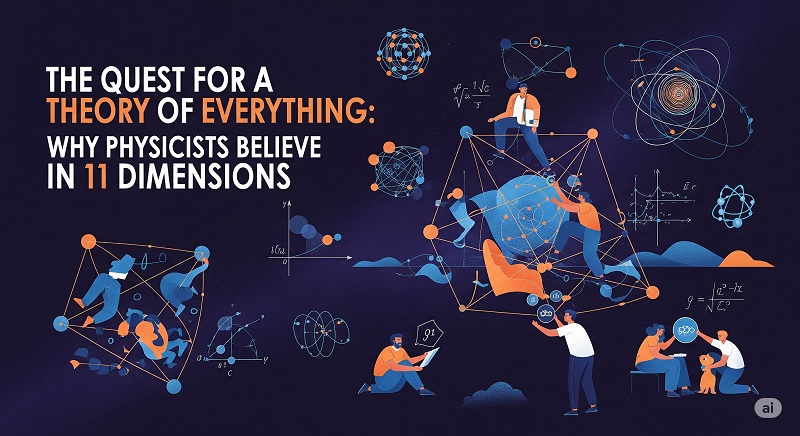Manoj Singh, Retired IAS, Ex ACS, UP Govt
How cutting-edge physics is revealing hidden dimensions that could explain the deepest mysteries of our universe
Lucknow: Imagine a world where the fabric of reality stretches far beyond the three spatial dimensions we perceive—height, width, and depth—and the fourth, time. What if reality is actually shaped by eleven dimensions, hidden from view yet essential for the existence of everything around us? This notion, which may sound like the stuff of science fiction, is at the heart of M-theory, a revolutionary framework in theoretical physics that could be the long-sought “Theory of Everything”—a unified explanation for all forces and particles in the universe.
The road to this idea stems from a deep conflict in modern physics. On one hand, Einstein’s theory of General Relativity provides a precise model of gravity and the structure of spacetime at large scales—from planets to galaxies. On the other, Quantum Mechanics governs the chaotic, probabilistic world of subatomic particles. Each theory works beautifully in its own realm, but they clash violently when applied to extreme scenarios like black holes or the moment of the Big Bang. In those realms, gravity and quantum effects are equally important, yet the two theories contradict each other or break down entirely. As Caltech physicist Dr. Maria Spiropulu says, “We have two rulebooks for the universe, and they don’t speak the same language. A Theory of Everything would be the ultimate translation.”
The most promising candidate for this unifying theory emerged in the 1970s as String Theory. It offered a radical idea: that all fundamental particles are not point-like dots but rather tiny, vibrating loops of energy—strings. The different ways these strings vibrate determine the nature of particles, much like different vibrations of a violin string produce different notes. But this elegant idea came with a caveat: the math only works if the universe has ten dimensions—nine spatial and one temporal. Without these extra dimensions, the equations fall apart.
Why should the universe need more dimensions than we can see? String theory proposes that extra dimensions are essential because they provide the space within which strings can vibrate in diverse ways to produce all known particles and forces. Just as sound needs air to travel, strings need higher-dimensional “space” to move and interact. Yet even this wasn’t the end of the story.
In 1995, theoretical physicist Edward Witten stunned the scientific community by revealing that the various competing versions of string theory were actually different aspects of a single, more profound theory, which he called M-theory. This new theory didn’t require ten, but eleven dimensions. The extra dimension added a new level of symmetry and explanatory power. It introduced entirely new entities called branes (short for membranes), which can stretch across multiple dimensions. Our universe, Witten proposed, could be a 3-brane—a four-dimensional bubble floating in an 11-dimensional space known as the bulk.

This shift had profound implications. First, it offered a potential explanation for one of the universe’s biggest puzzles: why gravity is so weak compared to other fundamental forces. M-theory suggests that gravity might be “leaking” into the extra dimensions, explaining why we feel only a faint remnant of its full strength. Second, it introduced the mind-bending idea of parallel universes. If other branes exist in the bulk, they might host entire universes, each with its own laws of physics, evolving independently of ours. Third, it may unlock new insights into the true nature of black holes. According to M-theory, black holes might be higher-dimensional entities called black branes, which behave differently than the ones predicted by conventional gravity.
But if these extra dimensions are real, why can’t we see them? Physicists propose two answers. One is that the extra dimensions are compactified—so tightly curled up at the Planck scale (about 10⁻³⁵ meters) that they are effectively invisible to us. The second is more conceptual: that we are “stuck” on our 3-brane, much like characters in a two-dimensional cartoon unaware of a third dimension. In this view, the additional dimensions surround us, but we simply lack the senses or instruments to perceive them—except perhaps through gravity, which is free to wander through the full 11D cosmos.
Testing these ideas remains one of the biggest challenges in physics. While we don’t yet have definitive proof of extra dimensions, cutting-edge experiments continue to look for signs. The Large Hadron Collider (LHC) at CERN could, in theory, produce microscopic black holes—a smoking gun for extra dimensions. Gravitational wave detectors might also pick up subtle distortions caused by hidden dimensions influencing spacetime ripples. These are early steps in a long journey, and critics argue that M-theory is more mathematical conjecture than empirical science. But proponents counter that revolutionary ideas often begin as theoretical dreams. After all, Einstein’s general relativity once seemed abstract and untestable—until experiments proved it right.
If M-theory turns out to be true, it would be one of the greatest intellectual achievements in human history. It would unify all known forces under a single, elegant framework, reveal hidden aspects of reality, and possibly even lay the foundation for advanced technologies—like warp drives or quantum gravity machines—currently confined to the realm of imagination. As string theorist Dr. Brian Greene beautifully summarizes, “We may be like fish unaware of the water they swim in. The extra dimensions are there—we just need to learn how to see them.”
The journey to discover a Theory of Everything is still underway. But with 11 dimensions as their compass, physicists are mapping the contours of an invisible universe—one that could finally explain why the cosmos is the way it is, and why we are here to ponder its mysteries.





